
Olympia is the capital of the U.S. state of Washington and the county seat and largest city of Thurston County. It is 60 miles (100 km) southwest of the state's most populous city, Seattle, and is a cultural center of the southern Puget Sound region.

Thurston County is a county located in the U.S. state of Washington. As of the 2020 census, its population was 294,793. The county seat and largest city is Olympia, the state capital.
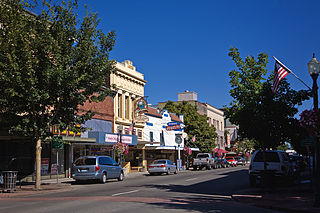
Centralia is a city in Lewis County, Washington, United States. It is located along Interstate 5 near the midpoint between Seattle and Portland, Oregon. The city had a population of 18,183 at the 2020 census. Centralia is twinned with Chehalis, located to the south near the confluence of the Chehalis and Newaukum rivers.

Chehalis is a city in and the county seat of Lewis County, Washington. The population was 7,439 at the time of the 2020 census. It is the county seat of Lewis County.
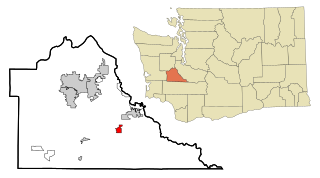
Rainier is a city in Thurston County, Washington, United States. Beginning as a train stop in the 1870s, Rainier was first settled in 1890, and was officially incorporated in 1947. The population was 2,369 at the 2020 census.
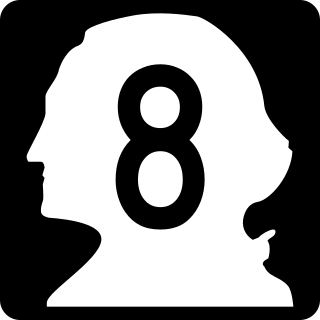
State Route 8 (SR 8) is a state highway in Grays Harbor and Thurston counties, of the U.S. state of Washington. It extends 20.67 miles (33.27 km) from U.S. Route 12 (US 12) in the city of Elma, east to an interchange with US 101 about 5.90 miles (9.50 km) northwest of the state capital, Olympia. SR 8 intersects SR 108 west of McCleary. The route connects Elma and Olympia as part of a corridor between Aberdeen and the Puget Sound region.

Salkum is a rural unincorporated community in Lewis County, Washington. The town is located on U.S. Route 12 and is 2.1 miles west of Silver Creek.
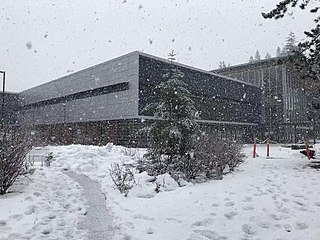
South Puget Sound Community College is a public community college in southwest Olympia, Washington. The college contains 125 acres (0.51 km2) and is serving about 5,300 full and part-time students as of the fall 2020 quarter.

State Route 507 (SR 507) is a Washington state highway in Lewis, Thurston and Pierce counties that extends 43.52 miles (70.04 km) from Interstate 5 (I-5) and U.S. Route 12 (US 12) in Centralia to SR 7 in Spanaway. The highway also intersects SR 510 in Yelm and SR 702 in McKenna. The first appearance of the roadway on a map was in 1916 and since, two highways, Secondary State Highway 5H (SSH 5H) and SSH 1N, were established on the current route of SR 507 in 1937 and 1943. They both became SR 507 during the 1964 highway renumbering.

Twin Transit is a public transit system serving the cities of Centralia and Chehalis in Lewis County, Washington. It operates four local transit bus routes and a fifth cross-county bus route, along with options for Dial-A-Ride and paratransit. The agency was founded in 1976 and began operating on November 1, 1977.
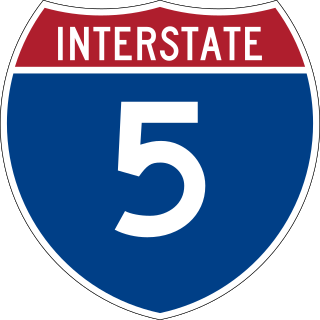
Interstate 5 (I-5) is an Interstate Highway on the West Coast of the United States, serving as the region's primary north–south route. It travels 277 miles (446 km) across the state of Washington, running from the Oregon state border at Vancouver, through the Puget Sound region, and to the Canadian border at Blaine. Within the Seattle metropolitan area, the freeway connects the cities of Tacoma, Seattle, and Everett.

Tono is a ghost town in southwest Washington in the United States. It was a company-owned mining town founded in 1907 by the Washington Union Coal Company, a subsidiary of the Union Pacific Railroad to supply coal for their steam locomotives. Tono was located in southern Thurston County about 20 miles (32 km) south of Olympia, Washington, 5 miles (8.0 km) south of Tenino, 2 miles (3.2 km) east of Bucoda at the end of a railroad spur. The town was named Tono in 1909 by one of the many Japanese railroad workers. Folk etymology states the name is a contraction of "ton of coal".

State Route 121 (SR 121) is a state highway located entirely in Thurston County, Washington, United States. The highway serves Millersylvania State Park, forming a 7.67-mile (12.34 km) loop between two interchanges with Interstate 5 (I-5) near Maytown. It is an auxiliary route of U.S. Route 12 (US 12).

The Puget Sound region is a coastal area of the Pacific Northwest in the U.S. state of Washington, including Puget Sound, the Puget Sound lowlands, and the surrounding region roughly west of the Cascade Range and east of the Olympic Mountains. It is characterized by a complex array of saltwater bays, islands, and peninsulas carved out by prehistoric glaciers.
Joseph Henry Wohleb (1887–1958) was an American architect from Washington.

Mud Bay Logging Company was a 20th-century logging company based in Olympia, Washington. The company was established in 1899 as Western Washington Logging Company by Mark Draham, who had previously established Mason County Logging Company. The name changed to Mud Bay Logging Company in 1910. The company was disestablished in 1941.
The Chronicle, formerly the Daily Chronicle, is a local newspaper in Centralia, Washington, US. The newspaper is owned by CT Publishing and publishes three editions per week.

Edmund Sylvester was an Oregon Territory and then Washington Territory pioneer. He was the founder of Olympia, Washington, in Thurston County, Washington.
The Centralia Canal, also known as Centralia Power Canal, is a canal in Thurston and Pierce counties, Washington, near the city of Yelm. It is the only feature named a canal in Western Washington. Its origin is on the Nisqually River, it is 9 miles (14 km) long, and it was built in 1929 to supply water for the 12-megawatt Yelm hydro project belonging to the city of Centralia's City Light Department.
The Chehalis, Washington park system is administered by the Chehalis Parks and Recreation Department. Trails that connect Chehalis with locations beyond the city limits are maintained in conjunction with other local jurisdictions, state government agencies, and/or local non-profit groups and volunteers.


















